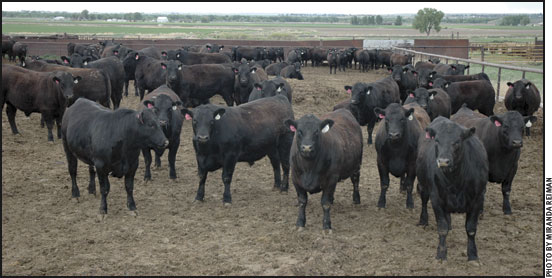 Average Doesn't Cut It On Grids
Average Doesn't Cut It On Grids
It's a pretty well-recognized fact: If you want grid premiums, your cattle have to be better than average.
Most people don't sell on a value-based system unless they have reasons to believe their herd genetics and management will result in high-quality beef. But even among ranchers who sell on a grid, the plant average factor — part of the formula used to derive grid pricing — is not as well understood.
"It affects producers in two ways," says Clem Ward, Oklahoma State University professor emeritus: "One, in terms of premiums and discounts and, two, in the form of base price."
Paul Dykstra, beef cattle specialist for Certified Angus Beef LLC (CAB), says the first point is pretty straightforward: "Plant average for percent Choice is the most common, and that percentage needs to be exceeded before most shipments of cattle realize net premiums."
"Mathematically, the way to handle that is to multiply the boxed beef Choice-Select [CH/SE] spread for the week by the plant-average percent Choice," Dykstra says. The spread minus that number is the premium applied to every Choice carcass on the grid.
If the carcass price base at that Nebraska plant is $185 and the CH/SE spread is $4, the Choice premium is $4 — (70% ✕ $4), or $1.20 added to the $185. The Select price would be $4 less than $186.20, at $182.20.
"Packers use a grid as a yardstick to value your cattle compared to everybody else's," says Ken Conway, president of GeneNet, a marketing alliance. "When they buy a set of cattle on the grid, many of the formulas use more than just a quality grade to adjust the base price."
A Choice Yield Grade (YG) 3 is usually the base.
"A lot of plants will have a 'clean-up' cost, where they'll figure averages on yield grade, quality grade and carcass weight," Conway says.
Some packers have yield grade allowances, too, where discounts don't kick in until the plant average YG 4 level has been reached. If the plant average was 6%, your load would have no YG 4 discounts unless they exceeded that, and then only on the excess. Plants that make YG 4 allowances typically combine that with steep YG 4 discounts once they kick in.
Neither plant averages nor allowances generally apply to premium quality brands and grades, however, and that's an added incentive for quality.
"Typically each Certified Angus Beef ® (CAB®) brand and Prime carcass would be awarded the full premium for those categories," Dykstra says.
Some producers might think this is a new scheme, but it's been going on since the inception of grids and really makes sense, the sources say.
"The plant management is only willing to pay a premium for those cattle that are above the average of the cattle they can go out and procure in a live market every week on their own," Dykstra explains.
Of course, they realize monetary incentive is the best way to get the type of cattle they need.
"They know their market for beef products and they need to have a certain percentage Choice to meet customer demands," Ward says. "If they're not getting that on the average, they're going to pay a premium to get more Choice.
"That's definitely out there as a target or incentive for the producers," he says.
So how can cattlemen figure out what that benchmark is in their region?
"The Northern cattle are going to have a higher percent Choice as a rule," says Dykstra, who has tracked weekly grading trends for years. Nebraska, Iowa and Illinois have reached 65% to 75% Choice recently, while Kansas is in the 60% to 65% range. Texas and the "Southern region" are closer to 50%, he says.
"As a seller, the further north you go, the higher the bar is set to get premiums," Dykstra notes.
Conway says that doesn't necessarily mean that the Southern cattle are at an advantage, or that a Northern feeder of high-quality cattle would be ahead to ship cattle to a Southern plant.
"Once you figure trucking, regional pricing and other factors it often evens out," he says.
Grading trends have changed over the years, and they vary seasonally, so the best way for a producer to know what they're up against is to ask.
"Talk to whoever is offering the grid," Conway says. "I get the question all the time, 'What kind of cattle do I need to have just to break even on the grid?'"
Dykstra says the bottom line is that grid-sold cattle need to be above average to justify that marketing channel, and producers need to know what average is.
"This certainly points toward the importance of carcass data collection and a general awareness of what type of genetics, breeds, nutrition and management will allow you to achieve your carcass quality goals," he says. "If your cattle aren't better than average, then they need to be sold live or on the rail for a flat price."













